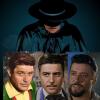|
GUY WILLIAMS CAREER TRIBUTE GALLERY #01 |
Updated: December 13, 2025








.jpg)


























































































Guy Williams started in the acting business in the early 1950's as a professional model, through the "Powers Model Agency" in
New York. When Davy Crockett & The Mickey Mouse Club was doing well for Walt Disney in 1954. The idea of doing "Zorro" for
television was in the works for 1957. Guy went to Hollywood to try out for the part, and got the job. For two great years, Zorro
was a smash hit with millions of kids, and the parents loved it too. The ZZZZZ's were everywhere, but the show was cancelled. The
show was on hold and Guy's contract with Disney was in limbo. During that time Guy Williams and cast members traveled the world as
a tour promotioning Zorro, and the show at Disneyland when possible. When ABC-Disney finally ended the disput Guy was released
from his contract.
Producer Irwin Allen quickly choosen Guy Williams as the leading role of his new fantasy, space adventure TV show for CBS in 1964,
and for 3 years from 1965-68 was the father and leader of the Jupiter-2 mission on Lost in Space. Born in 1924, Guy Williams was
one of the B-film stable of regular muscular good-guys of the 1950's & early 60's. Guy did several cameo's for television such as, Bonanza, Return to Honor, & Triangle. Guy also did 5 movies during his career such as, I was a Teenage Werewolf ( 1957 ), The Sign
of Zorro ( 1960 ), Damian & Pythias ( 1962 ), The Prince & the Pauper ( 1962 ), & Captain Sinbad ( 1963 ). After being disappointed with Hollywood, Guy decided to move to Buenos Aires in Argentina in 1973.
This page will highlight Guy Williams other acting performances both television & film.
|
 HOME
HOME
 About
About
 EMail Me
EMail Me TOP |
TOP |  PREVIOUS ITEM | NEXT ITEM
PREVIOUS ITEM | NEXT ITEM  ( 14 of 85 )
( 14 of 85 )








.jpg)


























































































